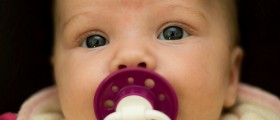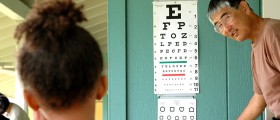
Baby eye problems may be congenital (when the baby is born with them) or acquired. Infections and drugs during pregnancy, as well as some genetic conditions might be responsible for the damage of the unborn baby’s eyes, while acquired eye problems usually appear after some infections, prolonged exposure to oxygen or some other causes.
Congenital Eye Problems in Babies
Different defects of parts of the eye can be responsible for eye problems in newborns. Globe defects, such as anophthalmos, microphthalmos, nanophthalmos, coloboma and congenital cystic eye may be causes of eye problems in babies.
Defects of the lids are also found to provoke eye problems in newborn babies, especially eyelid coloboma and congenital ptosis.
The cornea may be damaged in a way that the little patients experience partial or complete corneal opacity. This may be a result of forceps damage, intrauterine inflammation, interstitial keratitis, megalocornea, congenital glaucoma, endothelial developmental abnormalities or persistent attachment of lens.
Various defects of the pupil and the iris, such as aniridia, albinism, coloboma of iris, congenital cataracts, corectopia, heterochromia and polycoria can also be reasons behind baby eye problems. Congenital cataract can be either inherited or caused by mom’s rubella infection, but babies younger than 4 weeks are found to be exposed to higher risk of glaucoma due to cataract surgery. Vitreous bleeding is yet another possible complication of this condition.
Vitreous defects, as well as defects of the choroid and retina can all cause eye diseases in babies. Minor defects of the retinal vessels at nerve head and tilted disc are considered to be benign abnormalities, while optic nerve hypoplasia and central coloboma of the disc are more serious eye defects.
Poor vision might not have any apparent cause or be associated with extra ocular defects, like craniofacial abnormalities, dermoids or obstruction of nasolacrimal duct.
Acquired Eye Problems in Children
There are several acquired eye problems in small children. These conditions include conjunctivitis in the first 28 days of a baby’s life, known as ophthalmia neonatorum, retinopathy of prematurity (in babies with low birth weight), amblyopia (reduced function of vision in one or in both eyes, caused by some sensory deprivation, strabismus or anisometropia), strabismus (in some cases associated with retinoblastoma). Additionally, vigorous shaking of the baby, reported in abused children may lead to some eye problems (shaken baby syndrome). These children could experience intraocular or retinal bleeding, kids younger than 3 years of age. However, in rare occasions shaken baby syndrome can be a result of some infections or blood dyscrasias.







-In-Infants-And-Older-Children_f_280x120.jpg)









Your thoughts on this
Loading...